Three Design Styles, a Gelli Plate, and a Brush
One of my goals for this year is to learn surface pattern design. I want to move back and forth between art and design, and add more design to this blog as well. This week, I picked three of my favorite designers and played with Gelli Plate to imitate their style. These don’t replicate any of their work, just their style.
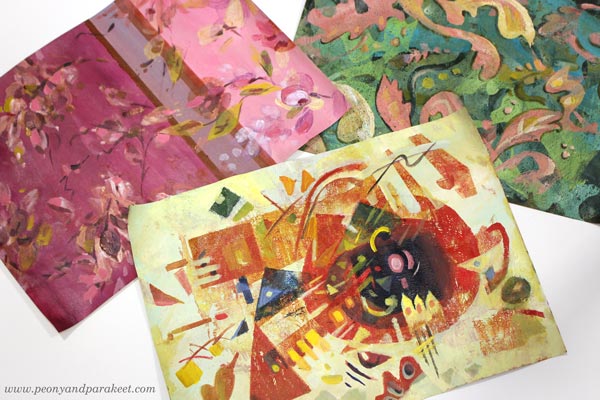
Three Designers from Three Centuries
My three favorite designers are Tricia Guild, William Morris, and Wassily Kandinsky.
Tricia Guild a designer from the UK, and she has a company Designer’s Guild, and I have been her fan since the 1990s when I discovered her book Design and Detail. It’s been my interior design guide for 30 years, and all my homes have got ideas from that book.
William Morris is also English, but he lived earlier, in the 19th century. Two rooms of our home have curtains designed by his company, and I regularly admire their clever repeats and ornamental shapes.
Wassily Kandinsky was more of an artist than a designer, but he taught designers in a famous Bauhaus art school in the early 20th century. For me, he is the father of modern design. I see his paintings in the works of most midcentury modern designers. Lately, he has felt even closer, when I have been built a class Floral Freedom that is based on his and Paul Klee’s teachings.
Who are your favorite designers?
Three Designers – Three Color Palettes
I have always liked making hand-decorated papers. Actually, my most popular blog post is this ancient one: How to Make Your Own Patterned Paper from 2010. So let’s get back to basics and make some!
First, I painted the backgrounds with acrylic paints and a flat brush. This set a color palette for each paper.
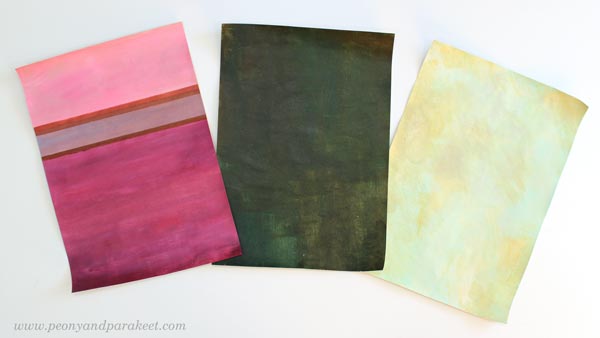
Muted pastels and rich darker tones remind me of Tricia Guild. She often uses stripes or checks too. William Morris has greyish colors and many of his designs have dark backgrounds. Wassily Kandinsky often had a very light background in his paintings.
Three Design Styles – Three Kinds of Shapes
I continued each of the papers by mono-printing motifs with a Gelli Plate. For Tricia Guild’s style, I used a small plate and painted the motifs with a brush on a plate, then pressed the plate on the paper. Because Tricia’s style is often quite relaxed, there was less pressure for perfect outlines.
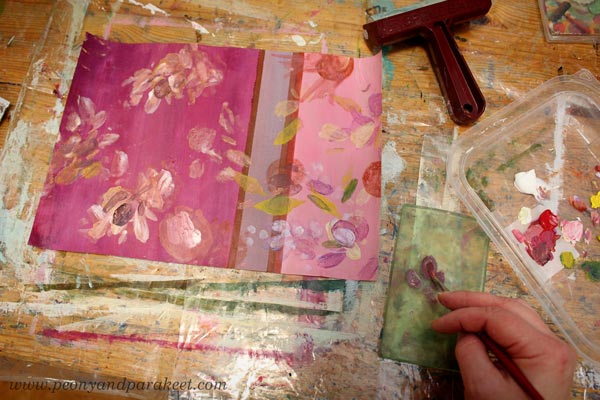
William Morris’s designs are very sharp and ornamental. I cut out ornaments freehand from paper and used both negative and positive shapes. I used both a big Gelli Plate and a small one.
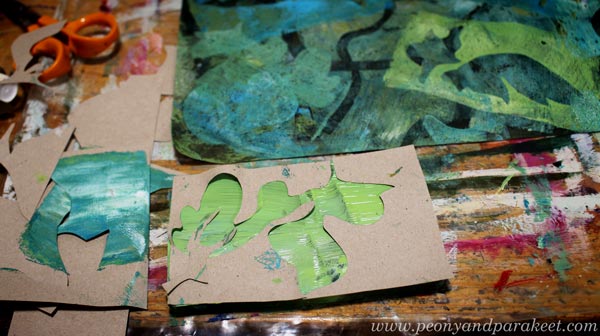
Here’s how the paper looked after mono-printing.
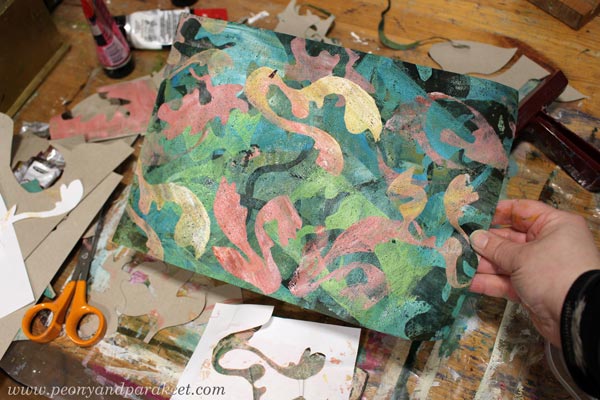
Wassily Kandinsky’s shapes are mostly geometric, so I cut templates that had circles, lines, squares and triangles.
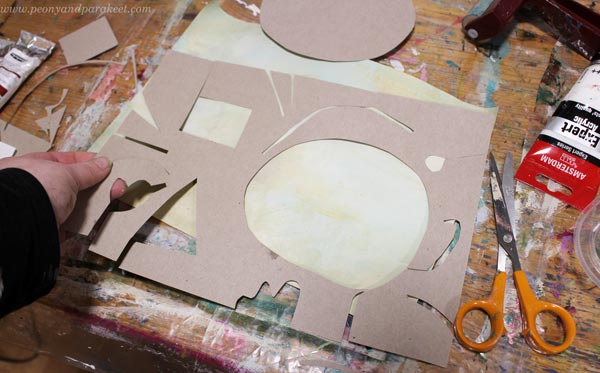
Here’s how the paper looked after mono-printing.
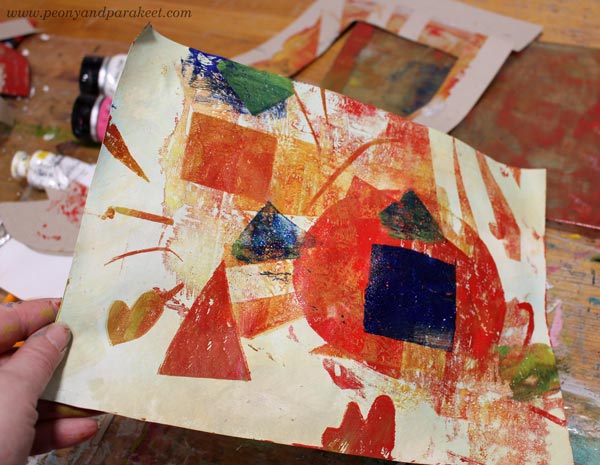
Three Design Styles – Three Levels of Detail
After mono-printing, I finished the papers by painting. I used a narrow brush and made small tweaks only.
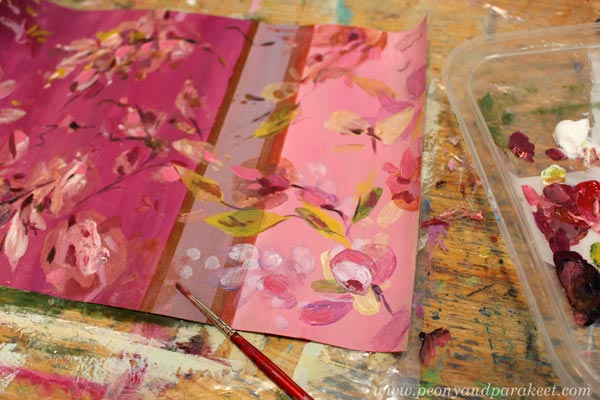
I like Tricia Guild’s designs because there modern meets classic and historical. They feel luxurious, but still comfortable. They don’t require similar perfection from the space than William Morris’s designs. So I didn’t perfect every shape or line, just added a bit more realism to the floral motifs. Here’s the finished paper.
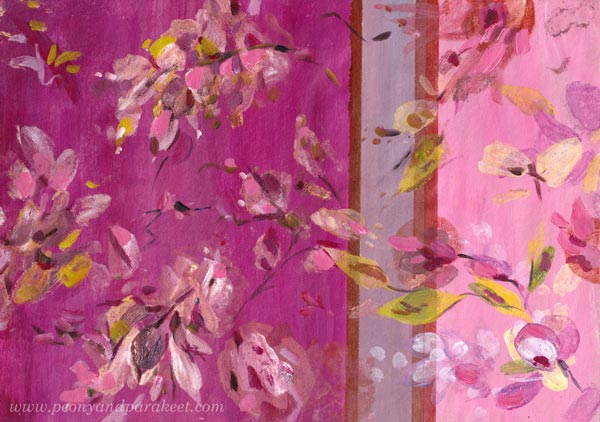
William Morris’s designs are full of outlined motifs, and I connect them with books. “For people who have a library,” I wrote in a notebook that I keep for studying. But I quite liked my mono-print, and didn’t want to stiffen everything. So I only outlined a part of the motifs, and added some small dots and thin lines inside the shapes.
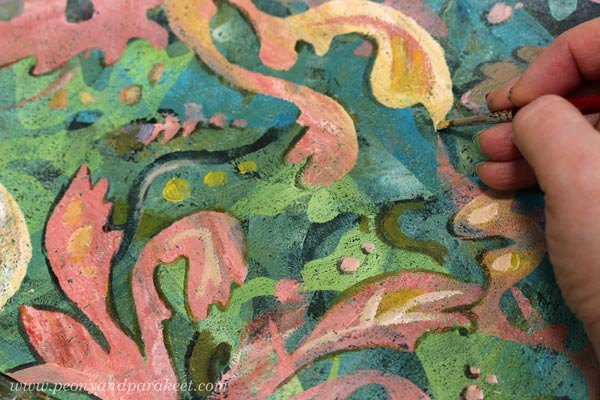
Here’s the finished paper. I really like the big yellow motif! Maybe that could be a part of my future designs.
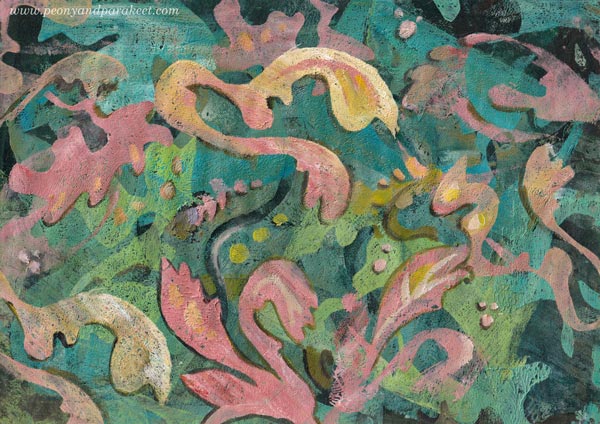
Wassily Kandinsky’s work didn’t lack details either. But if William Morris is for bookworms, then maybe Wassily is for systematic thinkers – for more scientific than humanistic introverts, and for those who love mathematics.
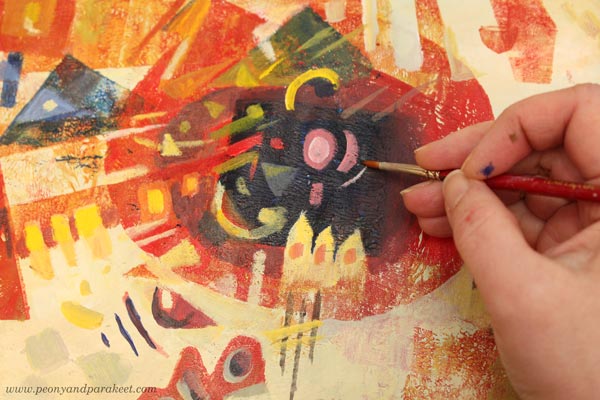
I used the monoprint as a foundation for the composition of shapes and followed Wassily’s advice and ideas from his book Point and Line to Plane, the book that I teach in the class Floral Freedom as well. Here’s the finished paper.
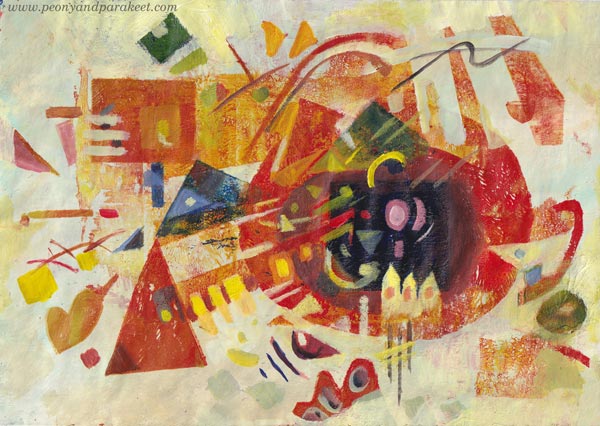
Three Wallpapers
I wanted to see how these papers could work as repeats. I didn’t have time to play with the repeats properly, but here are some quickly made images to demonstrate how the motifs would look in a smaller scale, for example, as a wallpaper.
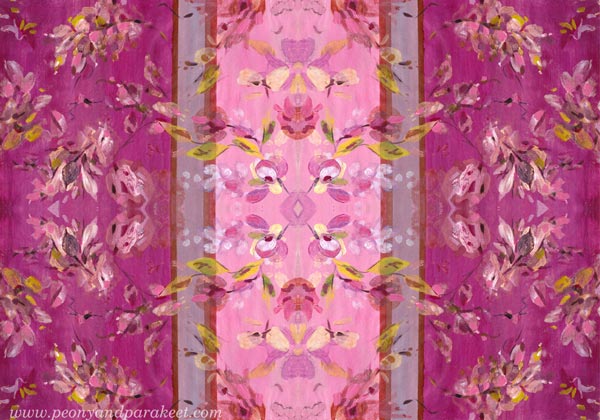
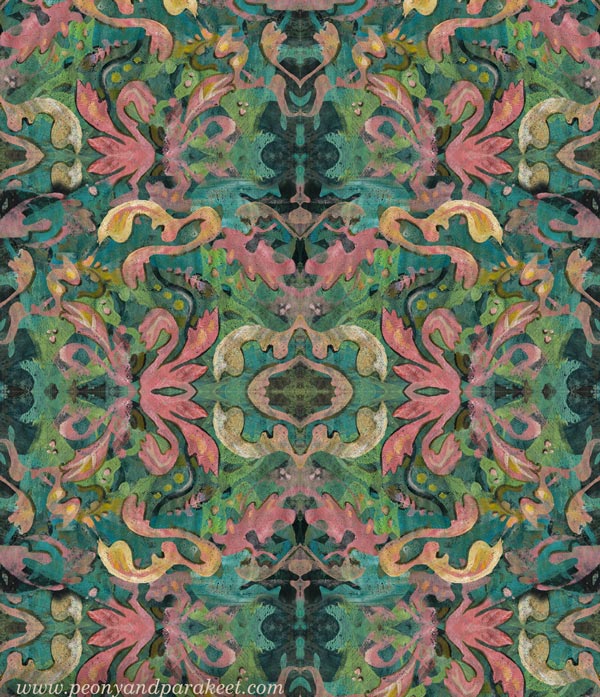
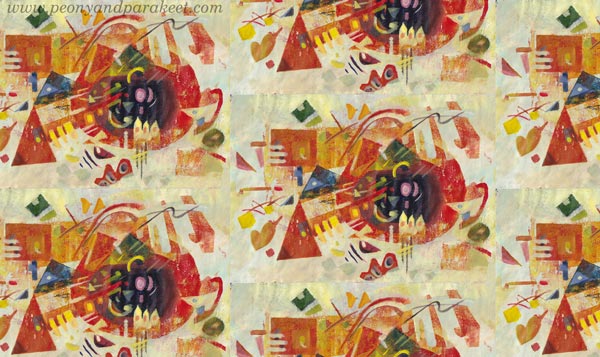
It was a full day, but I had fun making these! Tell me, which three designers would you pick?
Gelli Plate Meets Fine Art – Monoprinting Ideas for Art Lovers
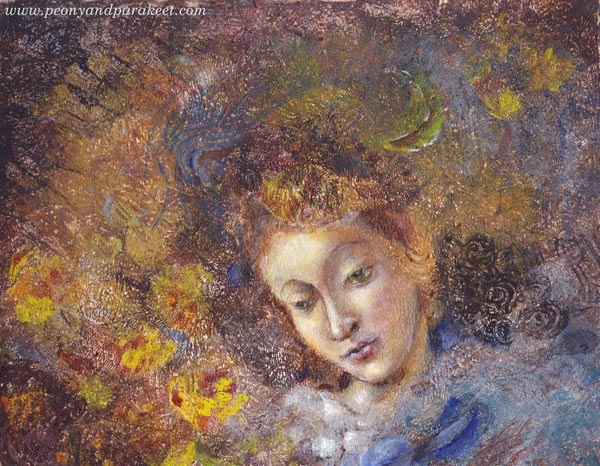
Old paintings are full of nuances and flow that we often don’t see when focusing on the subject only. This week, I am a rebel and use a Gelli plate for bringing up those elements. The Gelli Plate, like any mono-printing tool, is a bit clumsy for adding details. But also full of potential because you can easily produce repeated motifs that are not exactly similar. It enables you to add diversity and uplifting rhythm to your art without extra efforts.
Gelli Plate Meets Fine Art – Watch the Video!
This video is a replay of a live broadcast where I am sharing my secrets about the process.
I also include the images and the summary here in this blog post so that you can more easily refer back to these instructions.
Project 1 – Expressive Portrait on White Background
Supplies: Gelli Plates (mine are 8 x 10 and 3 x 5 inches), watercolor paper, brayer, brushes, any blunt stick, acrylic paints, glazing liquid (or gel medium).
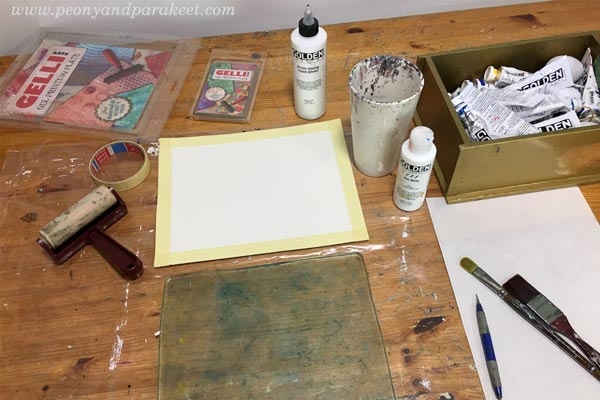
This project started by intuitively adding layers with a Gelli plate on a white watercolor paper.
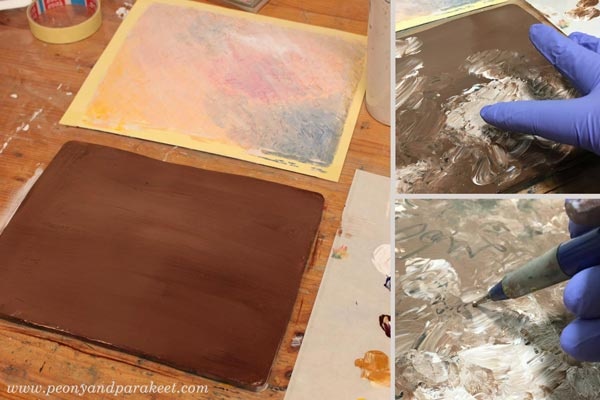
My only intention was to make a mess that has enough diversity so that I could see something appearing.
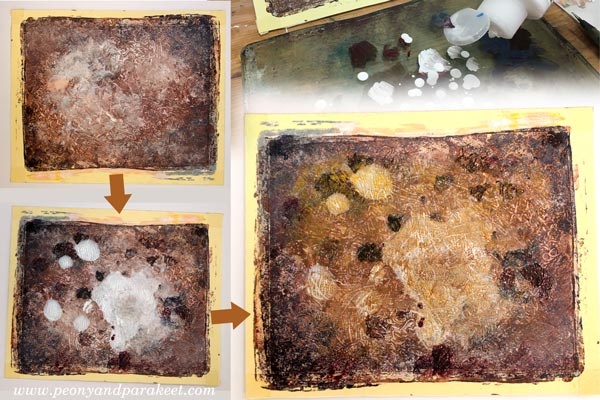
The big spot looked like woman’s face to me, so I made a stencil by quickly sketching one on paper.

I added more elements and shadows, so that worked one area at the time.

When the big elements were in their places, I changed to a smaller plate and added more details.
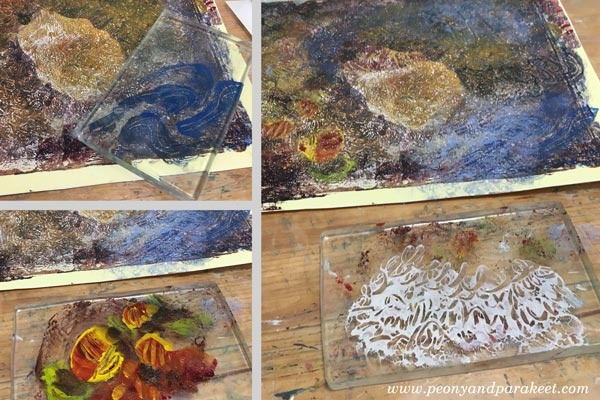
Here’s the monoprint before I changed to painting with brushes.
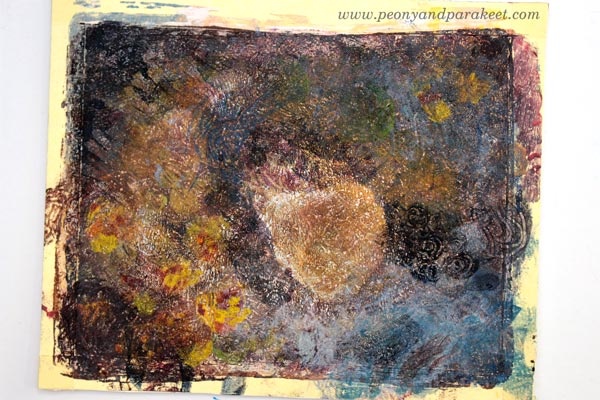
Using Botticelli’s Madonna of the Book as a loose reference, I painted the face and some details with fine brushes and thin layers.
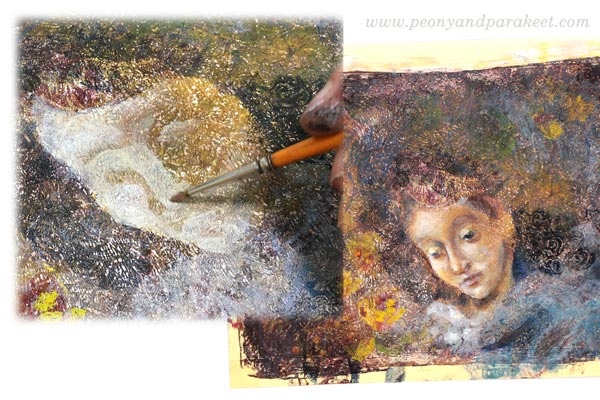
Here’s the close-up of the face. I realized that the eyes look to a bit different direction, but I didn’t want to change that because this piece is called Nostalgia. I think it’s a mixed feeling because then we are admiring the past, but at the same time, being sad that there’s no way to travel back in time.
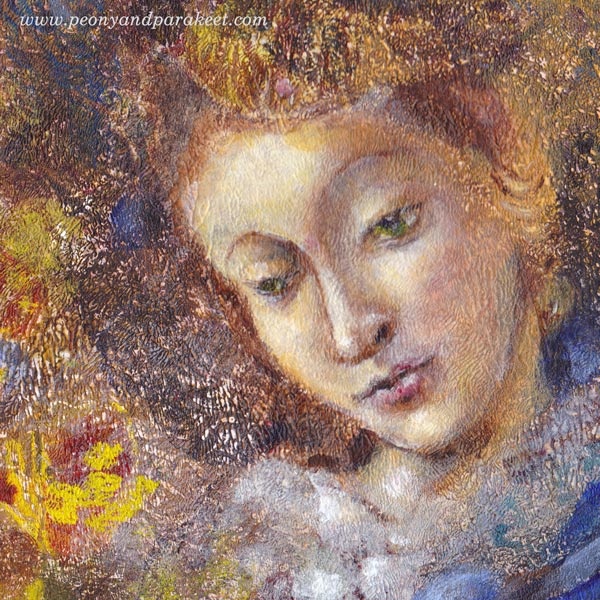
Here’s the full painting again.
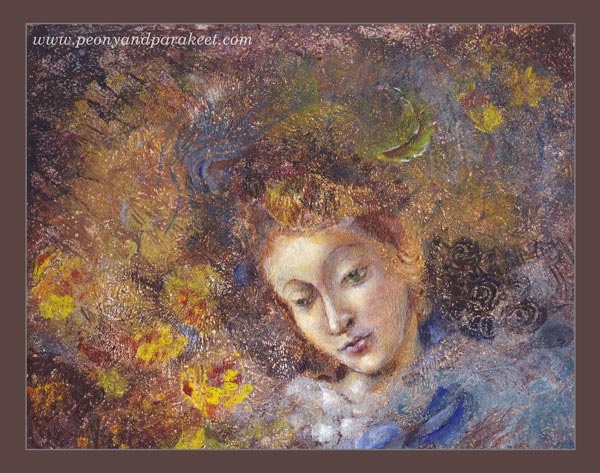
Do you like this one? The original piece is for sale in my shop!
Project 2 – Floral Still-Life on Black Background
This piece started by adding a layer of black gesso on a watercolor paper. I had a clear goal from the very beginning – to create a floral still-life honoring Dutch Golden Age paintings from the 17th century. I also wanted to use Gelli plates only and see if it’s possible to create a detailed piece by mono-printing only.
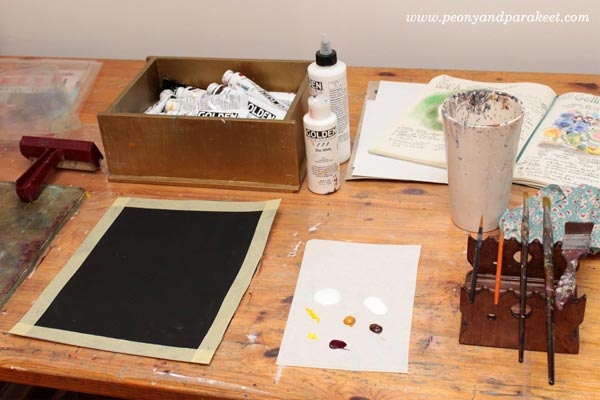
The first layers were very subtle and translucent. The idea is to build depth by slowly increasing the brightness of the mono printed layers.

Like in the previous project, many layers only had few elements. I like how detailed they look when adding lines with the stick on the plate.
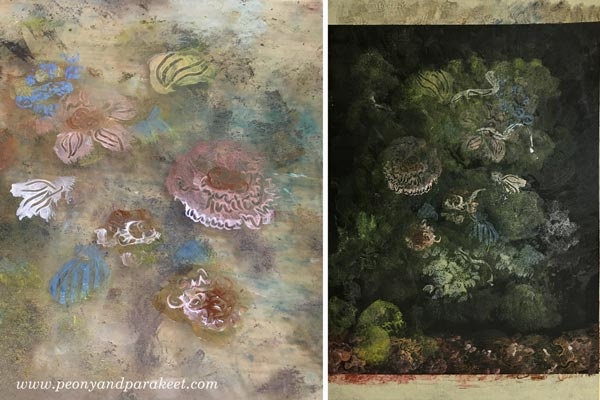
I also made a paper stencil for this project. At this point, I changed to a smaller plate.
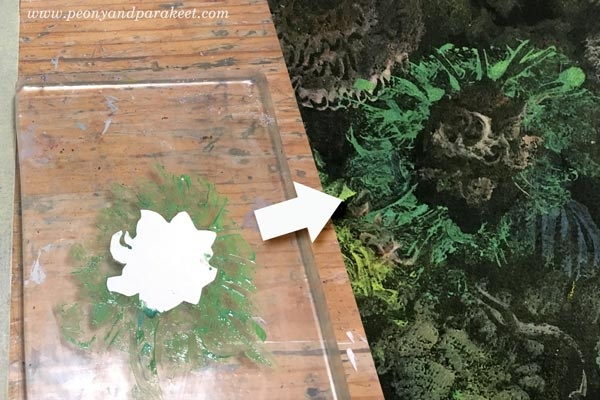
I used paler and darker tones of pink to make a flower. It’s also handy to stamp the same flower several times.
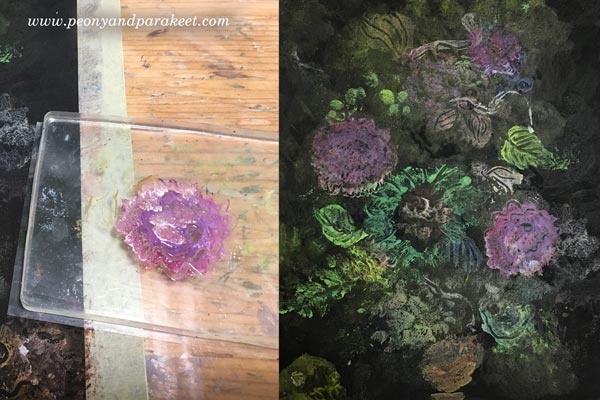
Dots and splashes of paint all add up. I also like to use cotton cloth for making a sharp edge to a free-form shape.
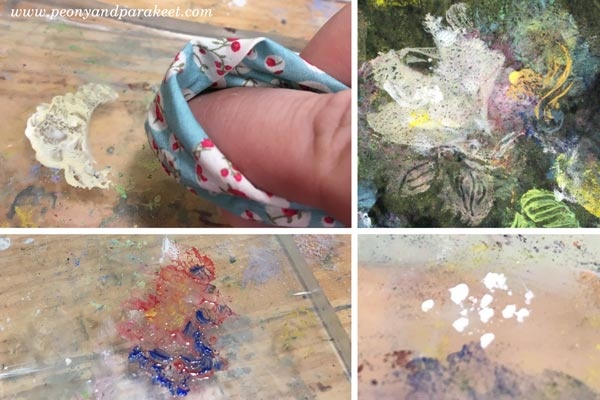
When using a little too much paint, it forms “skins” that look like intricate leaves. It was also fun to add a surface pattern to a vase.
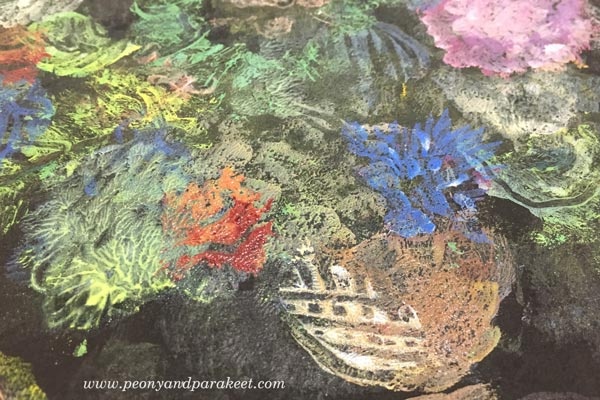
I used dark browns and black to tone down some elements, and white to highlight others.
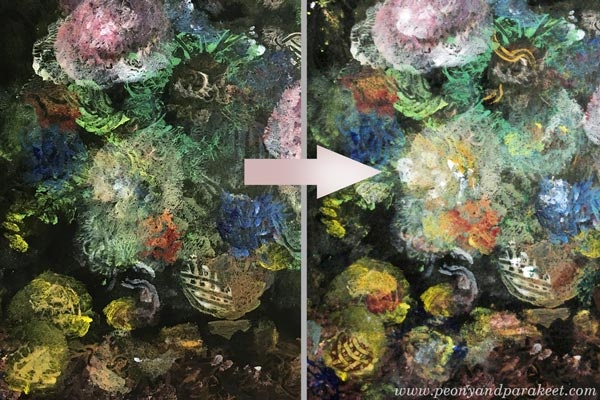
Here’s one of my favorite details:
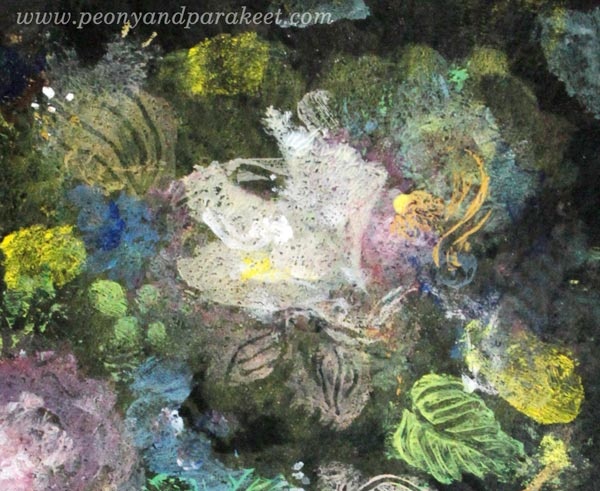
Another one, showing how the vase glows.
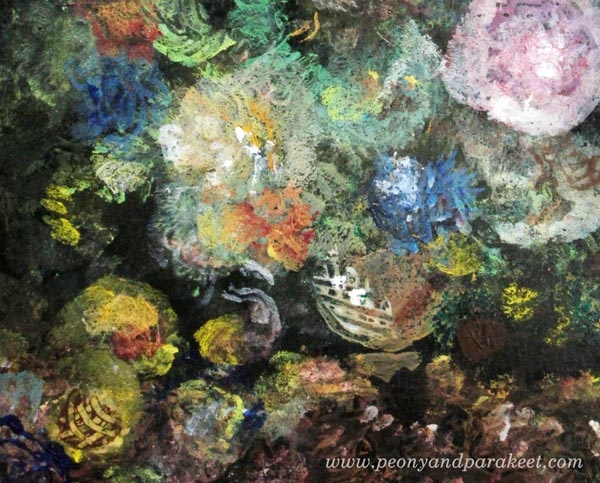
Here’s the finished piece in full size:

What next?
Continue to create with Paivi: Subscribe to my weekly emails
Learn the basics of mono-printing and create your visual wonderland: Buy Collageland
Stop the stiffness – let Paivi help you to move forward: Join Bloom and Fly
Subscribe to Paivi’s weekly emails – Get a free mini-course Loosen Up!
Coming Up: Fine Art Monoprinting!
I am running a free live broadcast Gelli Plate Meets Fine Art on Wednesday, May 23, 9 AM BST (London), 6 PM AEST (Sydney). This session is for you who loves old paintings from Renaissance to Impressionism but who also likes to play with Gelli plate or other mono-printing tools.
Inspiration from Historical Paintings
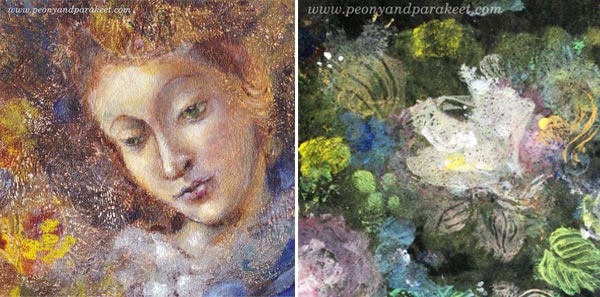
Old art is full of nuances and inspiration. I will show you how you can get more out of old masterpieces and apply the lessons to your art too. I will use two pieces as an example of how you can stretch Gelli plate’s limits. The first one has brushwork in addition to printed motifs. The second one is a still life that was made with a Gelli plate only. The pics of this post show some details of them.
Gelli Plate Meets Fine Art – Come Along!
Reserve your spot here: https://www.crowdcast.io/e/gelli-plate
You can watch the replay via the link or here on my blog if you can’t make it.
Intuitive Still Life with Gelli Plates and Golden Open Acrylics
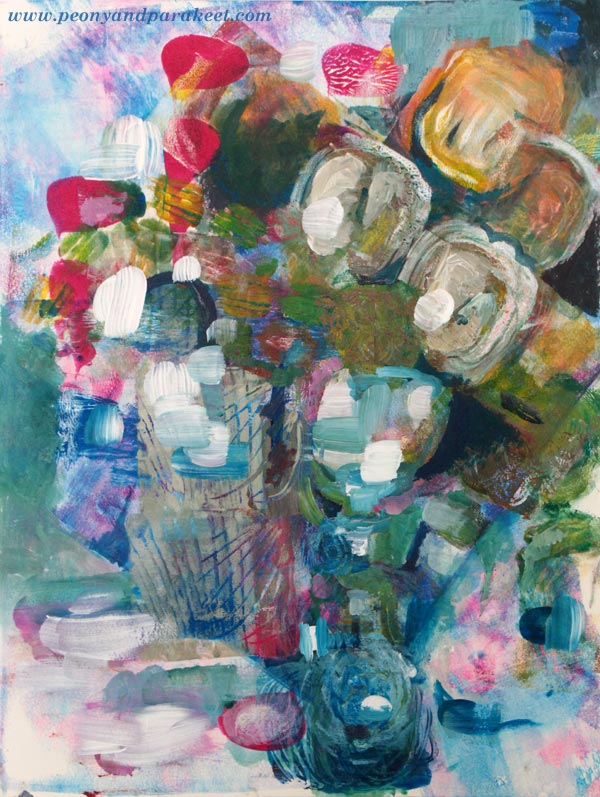
Here’s my latest painting, an intuitive still life with tulips. Last week, I had a short visit to an art supply store in Helsinki. I was surprised that they had a collection of Gelli plates for sale. When I got my first one several years ago, it wasn’t as accessible. I had to contact a shop in Italy which was the only retailer in Europe at that time. It’s great that Gelli plates have become more widely known. I have noticed that on my blog too. Month after month, the post “Self-Expression with Gelli Plate” is at top ten!
So I couldn’t help myself at the art supply store and bought another Gelli plate. My old one is 8 by 10 inches. The new one is a smaller, only 3 by 5 inches. It’s easier to handle and clean but mono printing with the big one is quicker.
Could Gelli Plates Be The Cure for Blank Paper Syndrome?
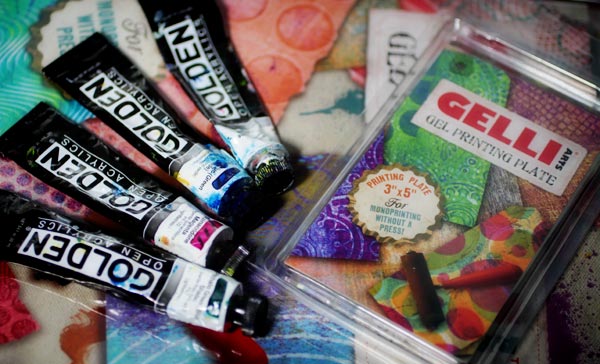
I wanted to have an experiment using both of the plates. Without any pre-planned idea about what my painting should represent, I would get over the blank paper syndrome using random monoprints. Then I would move on using brushes and working more intentionally. As always with mono printing, I used Golden Open Acrylics as paints because they don’t dry as quickly as regular ones.
Here’s my painting after I had some fun with Gelli plates.

And here’s the finished piece.
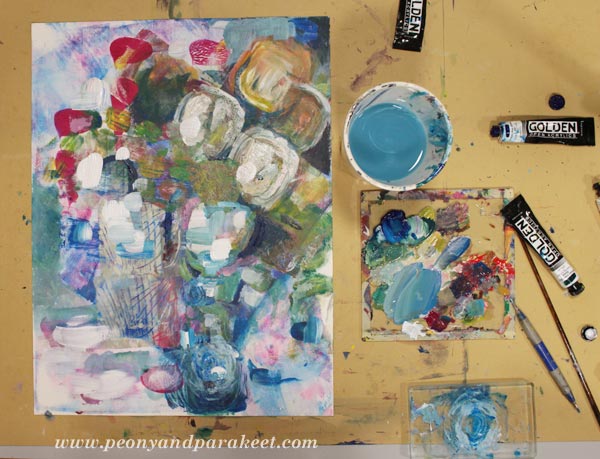
Intuitive Equals Subconscious!
After I had finished painting, I realized that it’s a combination of recent events: I got a lot of tulips for my birthday, made a strawberry birthday cake and enjoyed the winter sun with Stella.

Intuitive Still Life – Watch the Video!
Here’s a video about creating the intuitive still life. There you can see how adventurous my process was.
Enjoy creating more intuitively: Sign up for Inspirational Drawing 2.0!